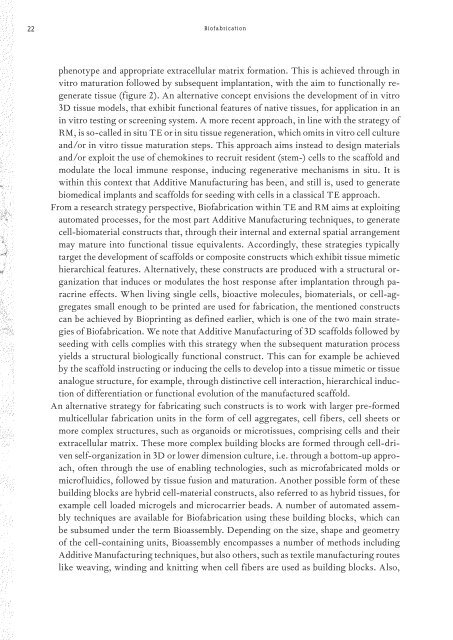Logbuch_17x24Druck_einzelseiten
Create successful ePaper yourself
Turn your PDF publications into a flip-book with our unique Google optimized e-Paper software.
22<br />
Biofabrication<br />
phenotype and appropriate extracellular matrix formation. This is achieved through in<br />
vitro maturation followed by subsequent implantation, with the aim to functionally regenerate<br />
tissue (figure 2). An alternative concept envisions the development of in vitro<br />
3D tissue models, that exhibit functional features of native tissues, for application in an<br />
in vitro testing or screening system. A more recent approach, in line with the strategy of<br />
RM, is so-called in situ TE or in situ tissue regeneration, which omits in vitro cell culture<br />
and/or in vitro tissue maturation steps. This approach aims instead to design materials<br />
and/or exploit the use of chemokines to recruit resident (stem-) cells to the scaffold and<br />
modulate the local immune response, inducing regenerative mechanisms in situ. It is<br />
within this context that Additive Manufacturing has been, and still is, used to generate<br />
biomedical implants and scaffolds for seeding with cells in a classical TE approach.<br />
From a research strategy perspective, Biofabrication within TE and RM aims at exploiting<br />
automated processes, for the most part Additive Manufacturing techniques, to generate<br />
cell-biomaterial constructs that, through their internal and external spatial arrangement<br />
may mature into functional tissue equivalents. Accordingly, these strategies typically<br />
target the development of scaffolds or composite constructs which exhibit tissue mimetic<br />
hierarchical features. Alternatively, these constructs are produced with a structural organization<br />
that induces or modulates the host response after implantation through paracrine<br />
effects. When living single cells, bioactive molecules, biomaterials, or cell-aggregates<br />
small enough to be printed are used for fabrication, the mentioned constructs<br />
can be achieved by Bioprinting as defined earlier, which is one of the two main strategies<br />
of Biofabrication. We note that Additive Manufacturing of 3D scaffolds followed by<br />
seeding with cells complies with this strategy when the subsequent maturation process<br />
yields a structural biologically functional construct. This can for example be achieved<br />
by the scaffold instructing or inducing the cells to develop into a tissue mimetic or tissue<br />
analogue structure, for example, through distinctive cell interaction, hierarchical induction<br />
of differentiation or functional evolution of the manufactured scaffold.<br />
An alternative strategy for fabricating such constructs is to work with larger pre-formed<br />
multicellular fabrication units in the form of cell aggregates, cell fibers, cell sheets or<br />
more complex structures, such as organoids or microtissues, comprising cells and their<br />
extracellular matrix. These more complex building blocks are formed through cell-driven<br />
self-organization in 3D or lower dimension culture, i.e. through a bottom-up approach,<br />
often through the use of enabling technologies, such as microfabricated molds or<br />
microfluidics, followed by tissue fusion and maturation. Another possible form of these<br />
building blocks are hybrid cell-material constructs, also referred to as hybrid tissues, for<br />
example cell loaded microgels and microcarrier beads. A number of automated assembly<br />
techniques are available for Biofabrication using these building blocks, which can<br />
be subsumed under the term Bioassembly. Depending on the size, shape and geometry<br />
of the cell-containing units, Bioassembly encompasses a number of methods including<br />
Additive Manufacturing techniques, but also others, such as textile manufacturing routes<br />
like weaving, winding and knitting when cell fibers are used as building blocks. Also,


